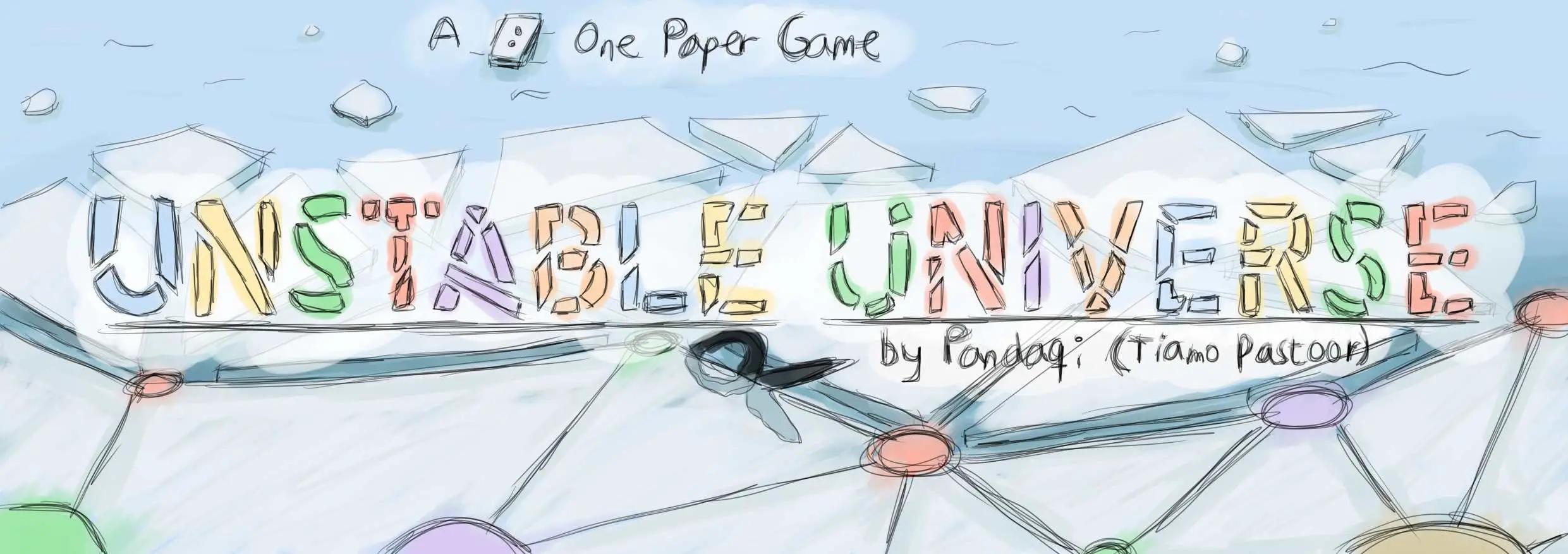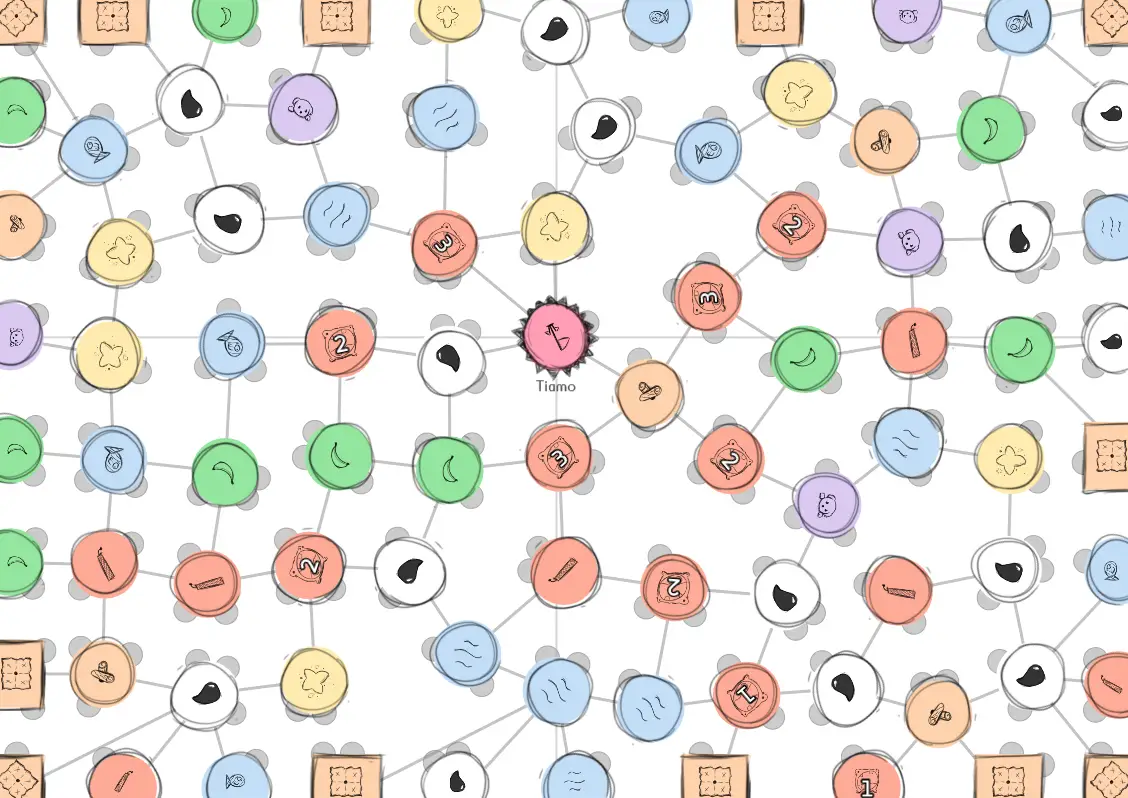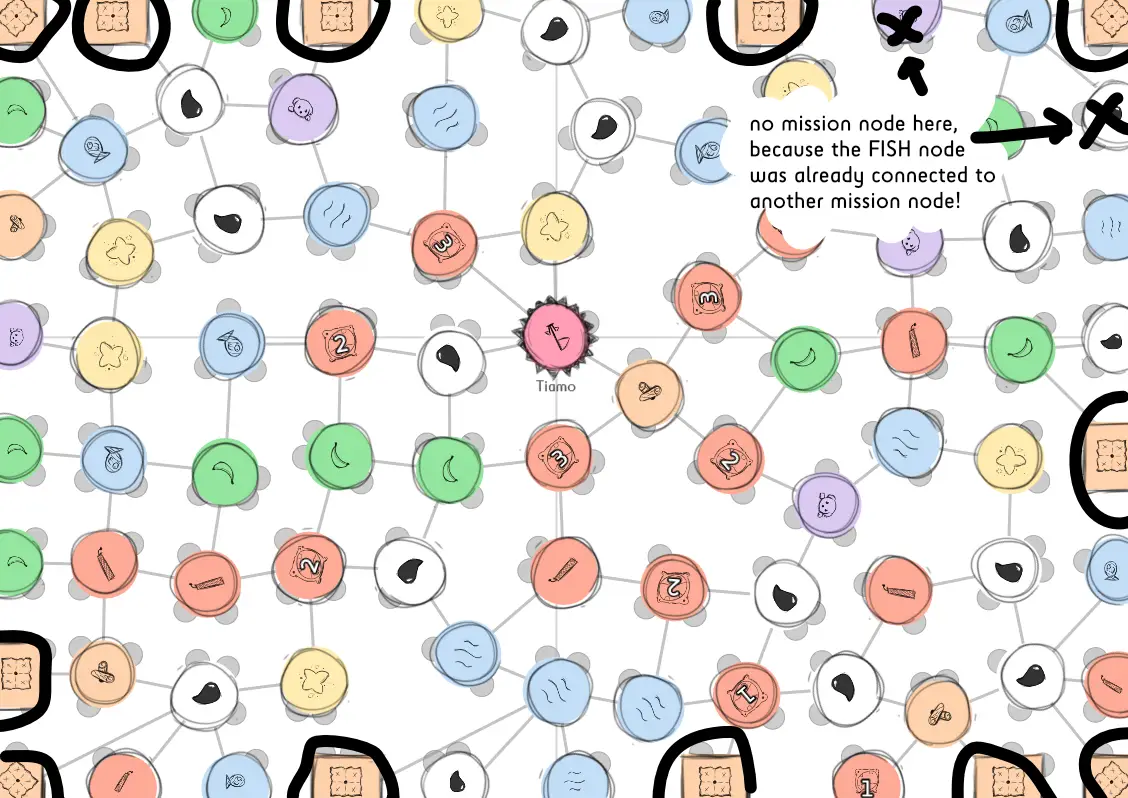
Unstable Universe (Part 1)
Welcome to the technical devlog about Unstable Universe!
If you haven’t yet looked at the game or played it, make sure to do so, otherwise what I talk about in this article won’t make much sense.
For this game, I needed to randomly generate player boards consisting of lots of nodes with edges between them. Like this:

In my earlier games, the boards always followed a strict (rectangular) grid or an even simpler method, so writing the code for such an organic board already proved quite a challenge. Making the board balanced and fair in all cases required even more ingenious algorithms, so let’s get started!
What’s the game all about?
In this game, all players start at the edge (at one of those rectangular nodes), and try to reach the center before anyone else.
There’s only one action: move. You pick a node you’re currently at, and move (via an edge) to an adjacent node. Simple as that.
When you land on the new node, you may take its action. And most of the time, that means a “cutting action”: you’re allowed to cut into the board.
When you do so, you must start from the edge of the paper or an existing cut, and follow the edges on the board. As you might expect: if a piece of paper is cut loose from the board, it’s gone. Out of the game.
As such, this game is a challenge between moving towards the center + grabbing useful nodes for your personal mission … and making sure you’re not cut off + strategically cutting off your opponents.
Below is a GIF which can probably explain this better:
(This is also posted on the homepage. I’m starting to like these short videos to explain a boardgame.)
Step 1: Placing Points
As you might expect, it’s vital that the randomly generated game boards are fair and balanced. If one side of the board, by accident, has way fewer nodes than the other side, or way fewer connections, you’re going to have a tough game.
Just before creating this game, I stumbled upon a technique called point relaxation, which ended up being the solution.
The idea is as follows:
Randomly place points on the map.
Now perform X relaxation steps (where X is something like 100):
For each node, look at the surroundings.
Calculate the vector between each node around us and ourselves.
Once we know all these vectors, sum them, and move the node by that much.
(Each step, reduce the maximum allowed movement by a little bit.)
What does this do? It tries to push each node away from other nodes that are too close. After doing this many times, each node will be at (roughly) equal distance from each other.
(On the website, it actually shows this relaxation happening. I decided to leave this in, because it looked interesting and it showed people what was happening. Otherwise you’d be staring at a blank page for a few seconds before the board suddenly popped up.)
It’s essential to reduce the movement each relaxation step, otherwise you’ll never find a “balance” and nodes will just race back-and-forth the whole time, as they are pushed around by their surroundings.
For this game, I decided on a “resolution” beforehand (how many nodes should fit on the width/height of the paper). So, if I wanted 20 nodes across the width, then the paper would be divided into sections 0-19. Then I forced nodes to keep at least a distance of 1, because that’s exactly how much room there should be for each node.
1const numIterations = 100;
2const numPoints = this.points.length;
3const equilibrium = 1.0;
4
5for(var i = 0; i < numIterations; i++) {
6 var stepSize = 2.0 / (i+1.0);
7
8 // first, determine velocity based on connections
9 for(var a = 0; a < numPoints; a++) {
10 var p = this.points[a];
11 var vel = [0,0];
12 var cX = Math.floor(p.x), cY = Math.floor(p.y)
13
14 var connections = // get list of nodes within X distance, whatever way you like
15
16 for(var c = 0; c < connections.length; c++) {
17 var p2 = connections[c];
18 var vec = [p.x - p2.x, p.y - p2.y]
19 var dist = Math.sqrt(vec[0]*vec[0] + vec[1]*vec[1]);
20
21 var force = 0, dir = 1.0;
22
23 // get the force (if node is closer, we're pushed away harder
24 // and the direction of the push
25 force = Math.abs(dist - equilibrium);
26 dir = (dist < equilibrium) ? 1.0 : -1.0;
27
28 if(force != 0) { vel = [vel[0] + dir*vec[0]*force, vel[1] + dir*vec[1]*force] }
29 }
30
31 p.relaxVelocity = vel
32 }
33
34 // then move all points based on that velocity
35 // NOTE: It's important to first calculate velocity on all nodes, and THEN move all nodes together
36 for(var a = 0; a < numPoints; a++) {
37 var p = this.points[a]
38
39 // cells at the edge of the paper are static in one direction; listen to that
40 if(p.staticX) { p.relaxVelocity[0] = 0; }
41 if(p.staticY) { p.relaxVelocity[1] = 0; }
42
43 // actually move
44 p.x += p.relaxVelocity[0] * stepSize;
45 p.y += p.relaxVelocity[1] * stepSize;
46 }
47}Remark: whenever a node is near the edge at the end of a relaxation step, I also snap it to the edge and don’t allow it to come off (it can still move in the other direction). This helped ensure there were enough edge nodes on every board. It also simply made boards look better.
Remark: I still use a grid system underneath this all. Why? Because it’s faster. If I want to know which nodes are around me, I simple check the few grid cells around me. And whenever a node moves, I just update which cell of the grid it should be in. This is way faster for large maps than checking the distance to all other nodes, especially when it comes to the following algorithm …
Step 2: Creating connections
In this game, the only thing you can do is move from one node to the next. As such, all nodes should be reachable from all other nodes, otherwise you can’t really play the game.
In Mathematics, such a board (with nodes and edges) is called a graph. They also have a name for the set of edges that ensures all nodes can be reached: a spanning tree.
An easy way to create such a spanning tree, is of course to connect everything with everything! That’s also an ugly way, which doesn’t work for a boardgame.
Instead, we want a minimum spanning tree. We want to connect everything with the minimum number of edges possible. For this, I used Prim’s Algorithm.
It works as follows:
Create an empty list L.
Pick any starting node, put it in L, mark it “visited”.
Repeat this until all nodes have been visited:
Define N: a node in the list L
Define M: a non-visited node that’s not in L.
Find nodes N and M with the shortest distance to each other.
Add M to the list and mark it “visited”.
Quite simple, but also quite slow because it looks at all nodes every time.
That’s why I implemented a grid underneath it all. If I know a node is in cell [2,2], then I know the nearest node is probably in its neighbors (the cells [1,2], [3,2], [2,1], [2,3]). If that fails, I cast a wider net, until I find something.
This requires some extra work (“bookkeeping” as Mathematicians like to call it), but is fast. For this game, I ended up with relatively small boards (only 80-90 nodes per game). But I initially tried this method on a way larger project with thousands of nodes, and it still got a valid result within a second.
Using this algorithm, we get something like this:

And here’s the code:
1var curPoint = this.points[0];
2curPoint.visited = true;
3
4var list = [curPoint];
5
6// use Prim's algorithm to build a minimum spanning tree from ALL points
7// NOTE: yes, we must do -1, because the last point has no new connection to make, so we terminate the iteration before that
8while(list.length < this.points.length - 1) {
9 var query = this.getClosestConnection(list); // again, implement any way you like => Euler distance, Manhattan distance, Grid, ...
10 var p = query.p, p2 = query.p2;
11
12 p.connections.push(p2);
13 p2.connections.push(p);
14
15 p2.visited = true;
16
17 list.push(p2);
18}Step 3: Filling the tree
This is a cutting game which can be played with a large player group. Having only ONE connection between nodes is not enough, we need some backups!
Allow me to introduce the “random fill tree” algorithm:
Keep looping through the nodes until we’ve added X extra edges.
For each node, find the nearest node, which:
Does not have a connection to it yet. (No sense in creating duplicate edges.)
Does not already have too many connections. (Depends on node type.)
If we find something, connect the two nodes.
In this case, I allowed starting nodes at most 2 connections, and other nodes at most 4. (Why do starting nodes get fewer? Because they only have half the board into which to draw edges, it’s likely that edges will overlap if they get more than 2, which is ugly and unclear for players.)
This algorithm is really simple. The complexity is hidden in the part that finds the “nearest node”: that function is a large bundle of loops and if-statements to efficiently find a node following certain conditions.
1const numExtraConnections = 40;
2const connectionMaximum = 3;
3
4// then go through all the other points
5for(var i = 0; i < this.points.length; i++) {
6 var p = this.points[i];
7
8 // Don't add connections if something already has too many of them
9 // Also don't add extra connections to edgePoints (high probability of creating overlapping edges)
10 if(p.edgePoint || p.connections.length >= connectionMaximum) {
11 continue;
12 }
13
14 var query = this.getClosestConnection([p], 'unconnected');
15
16 // there IS no closest connection, so continue without doing anything
17 if(query.p2 == null) { continue; }
18
19 // otherwise, make the connection we found (and we should always draw it)
20 var p2 = query.p2;
21
22 p.connections.push(p2);
23 p2.connections.push(p);
24}Remark: Later, when I was almost done with programming, I decided to call a similar function on the center node only. This function would give the center node as many connections as possible within a certain radius. Why? Because it’s important that every player can reach this node (as that is how you win the game), so I wanted as many edges as I could get.
Step 4: Determine starting nodes
During generation, I already save all nodes at the edge of the paper. In fact, I save them by side (“left”, “right”, “top”, “bottom”).
This allows me to pick three nodes from each side and convert them to starting nodes. (These are rectangular and get a special icon. That determines your personal mission for the game.)
At first, I did so randomly, but that quickly proved unfair. If your starting node was near the center of the edge, you had a way shorter path to victory than other players!
Instead, I sort the edges based on distance to the center node. Then I pick those furthest away.
I also added another exception because of this problem: if two starting nodes were connected with the same node … one of them would be worthless. Why? The player who happened to go first would snatch that node, and the other literally has nowhere to go.
So, when I create a starting node, I go through all its connections and set “hasStartingNode: true”. Later, if I want to create a starting node but one of its neighbors already has this property, I just skip that node and consider the next option.
1const edges = ['left', 'right', 'top', 'bottom'];
2const numPlayersPerEdge = 3;
3
4for(var e = 0; e < 4; e++) {
5 var edgeName = edges[e];
6 var edge = this.edgePoints[edgeName]
7
8 // first, sort all edge nodes based on distance to center
9 for(var i = 0; i < edge.length; i++) {
10 edge[i].distanceToCenter = Math.pow(edge[i].x - this.centerNode.x, 2) + Math.pow(edge[i].y - this.centerNode.y, 2)
11 }
12
13 edge = edge.sort(function(a,b) { if(a.distanceToCenter < b.distanceToCenter) { return 1; } else { return -1; } })
14
15 // then place mission nodes, with two restrictions:
16 // 1) as far away from center as possible (so pick first in sorted list)
17 // 2) they must have at least one connection that is NOT also used by another mission node
18 var counter = 0;
19 for(var i = 0; i < numPlayersPerEdge; i++) {
20 var p;
21 do {
22 p = edge[counter];
23 counter++;
24 } while (this.invalidMissionNode(p));
25
26 this.convertToMissionNode(p);
27 }
28}Remark: in case you were wondering “how do you pick the center node?”, the answer is probably exactly what you expect. When placing nodes, I mark the one closest to the center as “Center”, and that’s it. This allows some variation – because the node can drift off during relaxation – but also means I know the center node early on. Which is useful for coding other algorithms.

This devlog continues at part 2!